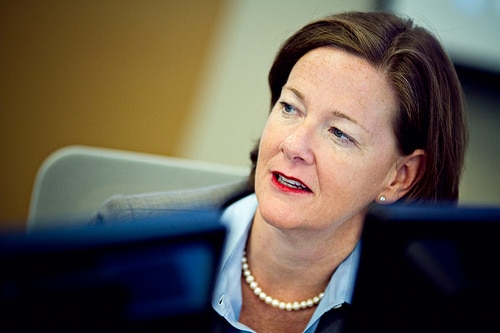This is the second post in a three-part series. For Part 1, Parsing Redford’s Little Black Lies, click here.
As Alberta Premier Alison Redford tries her best to hoodwink American politicians into believing Alberta is leading the way on climate change, it’s worth considering where the problems lie and how they might be addressed. The solutions, of course, have nothing to do with more and better public relations, just a commitment to environmental stewardship that Alberta has yet to embrace.
As I wrote in the first part of this column, Redford’s claims about “responsible oil sands development” in her recent USA Today column are patently false. This is because Alberta has failed to implement its own climate change strategy, allowing greenhouse gas (GHG) emissions in the province to grow significantly over the last 20 years despite a commitment to steep reductions.
There are three reasons for this failure. The first is the rampant expansion of Alberta’s tar sands development, which is the fastest growing source of GHG emissions in Canada. GHG emissions from the tar sands more than doubled over the last 20 years, and planned growth under current provincial and federal policies indicates they will double yet again between 2009 and 2020, from 45 megatonnes in 2009 to 92 million tonnes of greenhouse gases in 2020. Environment Canada knows full well that tar sands production, which is expected to double between 2008 and 2015, “will put a strong upward pressure on emissions.”
The second is our politicians’ unwarranted technocratic faith in technology, namely carbon capture and storage, to solve the GHG problem. Alberta’s climate change strategy relies on CCS for 70 per cent of GHG reductions. Although other countries have begun to capture and sequester carbon, Alberta hasn’t managed to get a single project up and running, and two projects have been cancelled altogether. This should come as no surprise. As far back as 2009, when I wrote about this issue for Alberta Venture, it was clear that CCS would not work in the tar sands, and that this nascent technology would be unable to reduce GHG’s while the Alberta government pursued its fantastical dream of becoming a dirty energy superpower.
The third is a combination of weak policy mechanisms that can actually achieve policy goals and objectives, and an unwarranted faith in industry to “do the right thing” without the need for strong policies. Alberta’s skyrocketing GHG emissions is adequate proof that the tar sands industry is unable or unwilling to reduce its carbon footprint. It’s also obvious that the $15 per tonne price on carbon Redford trots out as evidence of Alberta’s environmental leadership is more of a PR tactic than a meaningful market signal that will force industry to reduce its GHG emissions, either by limiting production or by implementing the necessary technologies that can reduce GHG intensity. There is ample evidence that a carbon tax of $150 per tonne is necessary to actually implement Alberta’s Climate Change Strategy.
This failure to implement Alberta’s (and Canada’s) climate change policies should come as no surprise to anyone following the environment file north of the Medicine Line. This is the way things are done in Canada these days. There are dozens of examples of politicians adopting policies and plans they have no intention of implementing while they carry on with their ideologically driven plans for business as usual.
As Redford (and Prime Minster Stephen Harper, her ally and counterpoint in Ottawa) blather on about “our readiness to demonstrate our strong track record on responsible oil (sic) sands development,” they need to understand that Americans and Canadians aren’t interested in more slick TV commercials and better messaging from the governments’ increasing staff of spin doctors. What we want and need is actual improvements in environmental performance in Alberta’s beleaguered and increasingly vilified tar sands and elsewhere.
If we want the world to love our dirty oil as much as we do, we’ve got to slow it down and clean it up. In this particular case, that means a meaningful price on carbon that forces the tar sands industry to get serious about reducing its carbon emissions. And if the power of the market and the innovativeness of industry aren’t up the task, then Canada can turn its attention to building the clean energy economy Canadians want and deserve. The sooner we figure this out, the better off we’ll be.
Image Credit: PremierofAlberta via flickr.
Subscribe to our newsletter
Stay up to date with DeSmog news and alerts







